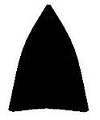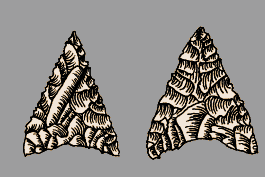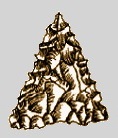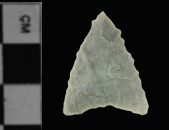Outline is Representative of Size and Shape:

Name Details:
Identified By: Eric Ritter and Louis A Payne
Named For: Guerrero Negro community near type site
Date Identified: 1992
Type Site: Laguna Ojo de Liebre (5LGN-1), Baja California, Mexico
Identified By: Eric Ritter and Louis A Payne
Named For: Guerrero Negro community near type site
Date Identified: 1992
Type Site: Laguna Ojo de Liebre (5LGN-1), Baja California, Mexico
Point Validity:
Valid type
Ritter was a distinguished anthropologist at the University of California. He conducted extensive research throughout Baja California. This point was identified in Ritter's Ph.D. dissertation and has several professional references. This is considered a valid type.
Ritter was a distinguished anthropologist at the University of California. He conducted extensive research throughout Baja California. This point was identified in Ritter's Ph.D. dissertation and has several professional references. This is considered a valid type.
Guerrero Negro Triangle
Cluster: Western Triangle Cluster Description of Physical Characteristics and Flaking Pattern:
This is a thin small to large triangular point with an elliptical cross section. The blade may vary from straight to slightly excurvate and commonly has fine serrations. The base is primarily straight, but may be slightly concave or slightly convex. This point is commonly well made with a random flaking pattern
Size Measurements:
Total Length - 10 to 60 mm, Total Width - 10 to 30 mm, Thickness - 2 to 8 mm
Total Length - 10 to 60 mm, Total Width - 10 to 30 mm, Thickness - 2 to 8 mm
Commonly Utilized Material:
Additional Comments:
Ritter (1998) notes that these points are commonly found in association with Spanish era relics. This is constant with the Guerrero (Mission) points found in Texas and northeastern Mexico. Green glass triangular points were found with Guerrero Negro points which is consistent with glass Guerrero points from Texas.
Loyd Doty notes:
GUERRERO NEGRO (Triangular) – is Spanish meaning Black Warrior. The Guerrero Negro series was defined by archaeologists Eric Ritter and Louis A. Payen, based on studies at the Laguna Guerrero Negro site (5LGN-1) in central Baja California. They are triangular points with concave or straight bases that occur in both large and small sizes. Ritter suggested that Guerrero Negro points “may possibly have served as harpoon tip inserts. Their distribution appears to be limited to coastal locations in west-central Baja. However large triangular points have also been reported from sites elsewhere in Baja California, including interior locations.
References: Ritter, Eric W. 2006a. South-Central Baja California. In The Prehistory of Baja California: Advances in the Archaeology of the Forgotten Peninsula, edited by Don Laylander and Jerry D. Moore, pp. 99-116. University Press of Florida, Gainesville. Ritter, Eric W. 2006b. The Vizcaíno Desert. In The Prehistory of Baja California: Advances in the Archaeology of the Forgotten Peninsula, edited by Don Laylander and Jerry D. Moore, pp. 135-152. University Press of Florida, Gainesville. Hyland, Justin R. 1997. Image, Land, and Lineage: Hunter-Gatherer Archaeology in Central Baja California, Mexico. Unpublished Ph.D. dissertation, Department of Anthropology, University of California, Berkeley.
Ritter (1998) notes that these points are commonly found in association with Spanish era relics. This is constant with the Guerrero (Mission) points found in Texas and northeastern Mexico. Green glass triangular points were found with Guerrero Negro points which is consistent with glass Guerrero points from Texas.
Loyd Doty notes:
GUERRERO NEGRO (Triangular) – is Spanish meaning Black Warrior. The Guerrero Negro series was defined by archaeologists Eric Ritter and Louis A. Payen, based on studies at the Laguna Guerrero Negro site (5LGN-1) in central Baja California. They are triangular points with concave or straight bases that occur in both large and small sizes. Ritter suggested that Guerrero Negro points “may possibly have served as harpoon tip inserts. Their distribution appears to be limited to coastal locations in west-central Baja. However large triangular points have also been reported from sites elsewhere in Baja California, including interior locations.
References: Ritter, Eric W. 2006a. South-Central Baja California. In The Prehistory of Baja California: Advances in the Archaeology of the Forgotten Peninsula, edited by Don Laylander and Jerry D. Moore, pp. 99-116. University Press of Florida, Gainesville. Ritter, Eric W. 2006b. The Vizcaíno Desert. In The Prehistory of Baja California: Advances in the Archaeology of the Forgotten Peninsula, edited by Don Laylander and Jerry D. Moore, pp. 135-152. University Press of Florida, Gainesville. Hyland, Justin R. 1997. Image, Land, and Lineage: Hunter-Gatherer Archaeology in Central Baja California, Mexico. Unpublished Ph.D. dissertation, Department of Anthropology, University of California, Berkeley.
Distribution:

Distribution Comments:
This point is primarily found along the coastal regions of central Baja California, Mexico.
This point is primarily found along the coastal regions of central Baja California, Mexico.
Age / Periods:
Date: 500 - 200 B.P.
Cultural Period: Prehistoric to Historic
Glacial Period: Little Ice Age
Culture:
Date: 500 - 200 B.P.
Cultural Period: Prehistoric to Historic
Glacial Period: Little Ice Age
Culture:
Age Details:
Other points in this cluster / Related / Associated Points:



